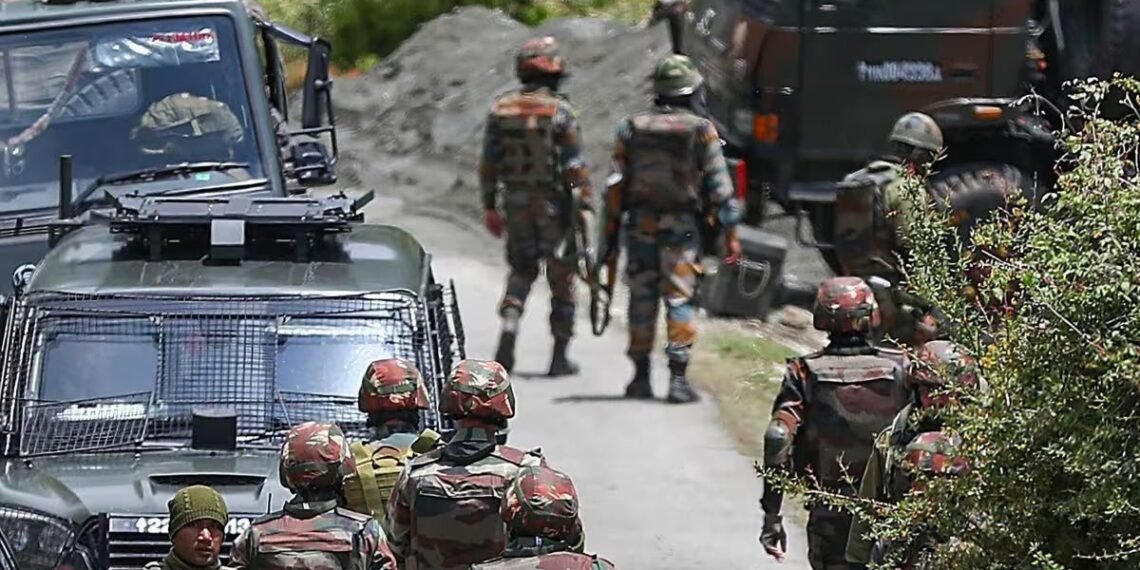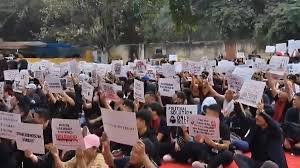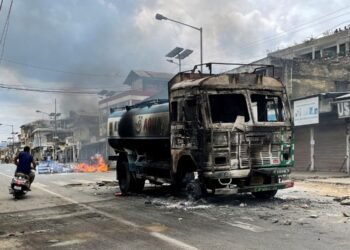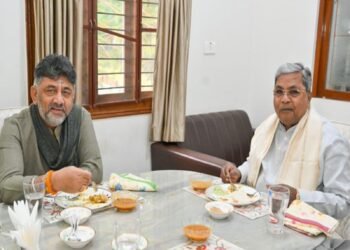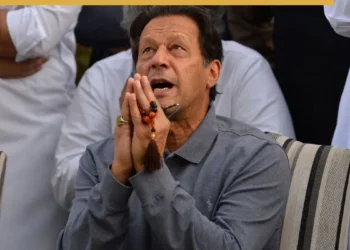Despite a landmark counter-terror strike and new infrastructure, J&K navigates persistent volatility. The year saw major operations against terrorist networks and the opening of the Chenab Rail Bridge, yet the region contends with civilian casualties, economic disruption, and ongoing cross-border tensions.
By Pravin Kumar
As Prime Minister Narendra Modi completes one year of his third term in office, India’s security forces have reported significant success in counter-terrorism operations, eliminating over 80 terrorists across Jammu and Kashmir.
However, the region remains volatile along the International Border and the Line of Control (LoC), particularly in the aftermath of Operation Sindoor, a decisive military strike targeting terrorist infrastructure in Pakistan and Pakistan-occupied Kashmir (PoK).
The year was marked by tragic losses, with 35 security personnel, predominantly from the Indian Army, sacrificing their lives in the line of duty. Meanwhile, the inauguration of the Chenab Rail Bridge and the launch of train services have sparked hope for economic revival in the Kashmir Valley, even as the region grapples with the fallout of terror attacks and a temporary dip in tourism.
A Year of Counter-Terrorism Success Amid Escalating Tensions
The past year has seen intensified counter-terrorism operations in Jammu and Kashmir, with security forces neutralizing over 80 terrorists. These operations, conducted by the Indian Army, Border Security Force (BSF), and other agencies, targeted terrorist hideouts and infiltration routes along the LoC and International Border.
The success of these efforts was underscored by Operation Sindoor, launched on the night of May 6-7, 2025, in response to a deadly terror attack in Pahalgam’s Baisaran Valley on April 22, 2025, which claimed 26 civilian lives, mostly tourists.
Operation Sindoor, described by Prime Minister Modi as “the biggest and most successful anti-terror operation in India’s history,” saw Indian forces destroy nine terror camps in Pakistan and PoK, eliminating over 100 terrorists and damaging key Pakistani airbases.
The operation, executed with precision strikes using drones and missiles, targeted terror hubs in Bahawalpur, Muridke, and Muzaffarabad, dealing a severe blow to Pakistan’s terror infrastructure.
READ: Manipur Security Gaps: Need for Full AFSPA Coverage After Deadly Imphal Rioting
Prime Minister Modi, addressing the nation on May 12, 2025, declared, “Terrorists wiped the sindoor off the foreheads of our mothers and sisters… so India reduced their terror headquarters to rubble.” He emphasized that the operation was a testament to India’s resolve to combat terrorism and its refusal to tolerate “nuclear blackmail” from Pakistan.
BIG: NIA strikes back at the terror ecosystem in J&K..
On June 5, searches were conducted at 32 locations targeting hybrid terrorists and overground workers linked to Pak-backed groups like TRF, JKFF, MGH & others.
A direct hit to Pakistan’s proxy war machinery! pic.twitter.com/wRFCWVdf77
— Hashtag_Kashmir (@Sher_i_Kashmir) June 6, 2025
However, the operation triggered retaliatory shelling from Pakistan, resulting in the deaths of at least 18 civilians, including four children, in Jammu and Kashmir. The volatile situation along the LoC and International Border led to heightened security measures, including a precautionary blackout in parts of Rajasthan and Punjab and the temporary closure of the Kartarpur Corridor.
Terror Attacks Mar Modi’s Third Term
The year began with a grim reminder of the persistent threat of terrorism. On June 9, 2024, the day Prime Minister Modi took the oath of office for his third term, a heavily armed group of terrorists attacked a pilgrim bus in Reasi district, targeting devotees visiting the Vaishno Devi shrine. This attack set a somber tone for the year, highlighting the challenges facing the Modi government in securing the Union Territory of Jammu and Kashmir.
Another significant provocation came on April 22, 2025, when Lashkar-e-Taiba terrorists executed 25 male tourists in the scenic Baisaran meadow near Pahalgam. The attack, which aimed to disrupt communal harmony and cripple the tourism-dependent economy of Kashmir, was condemned by Modi as an assault on “insaniyat” (humanity) and “Kashmiriyat.” A local Kashmiri Muslim, Adil, lost his life attempting to disarm a terrorist, underscoring the bravery of civilians caught in the crossfire.
In another blow to regional stability, a major flagship road construction project in Gangangir was derailed when terrorists attacked a labor camp, further disrupting development efforts in the region. These incidents, coupled with Pakistan’s retaliatory actions post-Operation Sindoor, contributed to a palpable sense of fear among locals and a temporary exodus of pilgrims and tourists from the Kashmir Valley.
READ: Free Movement vs. UT will Dominate June 9 MHA-Kuki-Zo Talks
Sacrifices of Security Forces
The cost of maintaining security in the region has been steep. Over the past year, 35 security personnel, the majority from the Indian Army, made the ultimate sacrifice in counter-terrorism operations and cross-border skirmishes.
The bravery of the BSF, particularly its women personnel, was highlighted during Operation Sindoor. An all-women BSF team, led by Assistant Commandant Neha Bhandari, defended forward posts in Akhnoor for three days against Pakistani artillery fire, earning praise from Prime Minister Modi for their role in showcasing India’s “nari shakti” (women’s power).
Operation Sindoor: A Strategic and Symbolic Triumph
Operation Sindoor, launched in response to the Pahalgam attack, was a landmark in India’s counter-terrorism strategy. Described as a “calculated and mission-oriented strike,” it targeted terror infrastructure deep within Pakistan, with Indian forces striking within 22 minutes of identifying targets. The operation was lauded for its precision and for showcasing the capabilities of India’s indigenous defense systems, with Modi emphasizing the role of “Make in India” in its success.
At the same time, the four terrorists responsible for the Pahalgam attack remain at large, raising concerns about the operation’s ability to deliver justice.
The operation also sparked diplomatic tensions, with U.S. President Donald Trump claiming credit for brokering a ceasefire between India and Pakistan on May 10, 2025, by threatening to halt trade with both nations. This claim was met with skepticism in India, where Kashmir is considered an internal issue, and opposition parties, including the Congress and Aam Aadmi Party, demanded clarity on whether the Modi government had accepted third-party mediation.
READ: Amid Violent Protests in Imphal, Yairipok SDC Office Set Ablaze
Infrastructure Milestones Offer Hope
Amid the security challenges, the inauguration of the Chenab Rail Bridge on June 6, 2025, marked a significant achievement for Modi’s third term. The world’s highest railway arch bridge, standing 359 meters above the Chenab River in Reasi district, is a key component of the 272-km Udhampur-Srinagar-Baramulla Railway Link (USBRL). Alongside India’s first cable-stayed Anji Khad Bridge, it has reduced travel time between Katra and Srinagar to approximately three hours, enhancing connectivity and boosting the region’s economy. The USBRL, completed at a cost of ₹43,780 crore, includes 36 tunnels and 943 bridges, navigating the challenging terrain of the Pir Panjal and Lower Himalayas.
Prime Minister Modi, during his first visit to Jammu and Kashmir post-Pahalgam attack, flagged off two Vande Bharat Express trains between Baramulla and Katra, signaling a return to normalcy. The rail link, equipped with CCTV surveillance and fire-resistant safety features, ensures all-weather connectivity, addressing the limitations of the Jammu-Srinagar highway, which is prone to weather disruptions. Modi also laid the foundation stone for the Shri Mata Vaishno Devi Institute of Medical Excellence in Katra, worth over ₹350 crore, and inaugurated road projects to improve last-mile connectivity in border areas.


